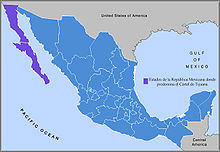 Areas predominantly controlled by the Tijuana Cartel shown in purple, 2008 | |
| Founded | 1987[1] |
|---|---|
| Founded by | Benjamín Arellano Félix, Ramón Arellano Félix |
| Founding location | Tijuana, Baja California, Mexico |
| Years active | 1987–present[2][1] |
| Territory | Mexico: Tijuana, Baja California, Baja California Sur United States: San Diego, Los Angeles |
| Ethnicity | Mexican |
| Leader(s) | Enedina Arellano Félix |
| Activities | Drug trafficking, money laundering, people smuggling, murder, arms trafficking, bribery[3] |
| Allies | Logan Heights Gang[4] Russian mafia[5] Los Palillos (later became rivals)[6] Cali Cartel (defunct) Border Brothers Norte del Valle Cartel (defunct) Oaxaca Cartel (defunct) |
| Rivals | Sinaloa Cartel(defunct) Los Cabos (CJNG cell in Baja California)[7] Gulf Cartel Los Palillos (in San Diego/Chula Vista)[8] DEA |
The Tijuana Cartel (Spanish: Cártel de Tijuana), formerly also known as the Arellano-Félix Cartel (Spanish: Cártel Arellano Félix, CAF), is a Mexican drug cartel based in Tijuana, Baja California, Mexico. Founded by the Arellano-Félix family, the cartel once was described as "one of the biggest and most violent criminal groups in Mexico".[9] However, since the 2006 Sinaloa Cartel incursion into Baja California and the fall of the Arellano-Félix brothers, the Tijuana Cartel has been reduced to a few cells. In 2016, the organization became known as Cartel Tijuana Nueva Generación (New Generation Tijuana Cartel) and began to align itself under the Jalisco New Generation Cartel, along with the Beltrán Leyva Organization (BLO) to create an anti-Sinaloa alliance, in which the Jalisco New Generation Cartel heads.[10] This alliance has since dwindled as the Tijuana, Jalisco New Generation, and Sinaloa cartels all now battle each other for trafficking influence in the city of Tijuana and the region of Baja California.
- ^ a b Beith, Malcolm (2010). The Last Narco. New York, New York: Grove Press. p. 47. ISBN 978-0-8021-1952-0.
- ^ Martínez, Julieta (6 January 2012). "El cártel de los Arellano Félix continúa: PGJE". El Universal. Archived from the original on 7 January 2012. Retrieved 7 January 2012.
- ^ McCAUL, MICHAEL T. "A Line in the Sand: Confronting the Threat at the Southwest Border" (PDF). House Committee on Homeland Security. Archived from the original (PDF) on 11 September 2011. Retrieved 12 October 2011.
- ^ Roebuck, Jeremy (March 9, 2010). "Violence the result of fractured arrangement between Zetas and Gulf Cartel, authorities say". The Brownsville Herald. Archived from the original on 2010-03-13. Retrieved 2010-03-12.
- ^ "Russian Mafia Helping Mexican Cartels". Archived from the original on 2021-05-15. Retrieved 2020-11-12.
- ^ "Femme Fatale Kidnapper Of CAF Members Has Appeal Denied In US Court". Borderland Beat. 26 August 2021.
- ^ "Los Cabos Leave Ice Chests With Remains and Threats for CAF in Sánchez Taboada, Tijuana". Borderland Beat. 23 September 2021. Archived from the original on 27 September 2021. Retrieved 27 September 2021.
- ^ "Femme Fatale Kidnapper Of CAF Members Has Appeal Denied In US Court". Borderland Beat. 26 August 2021. Archived from the original on 26 September 2021. Retrieved 26 September 2021.
- ^ Steller, Tim (15 April 1998). "Mexican drug runners may have used C-130 from Arizona". The Arizona Daily Star. Archived at California State University Northridge. Archived from the original on 2008-01-03. Retrieved 2007-09-26.
- ^ "Expert Says Weakened Sinaloa Cartel Under Attack by Rivals". 10 October 2016. Archived from the original on 11 October 2016. Retrieved 11 October 2016.